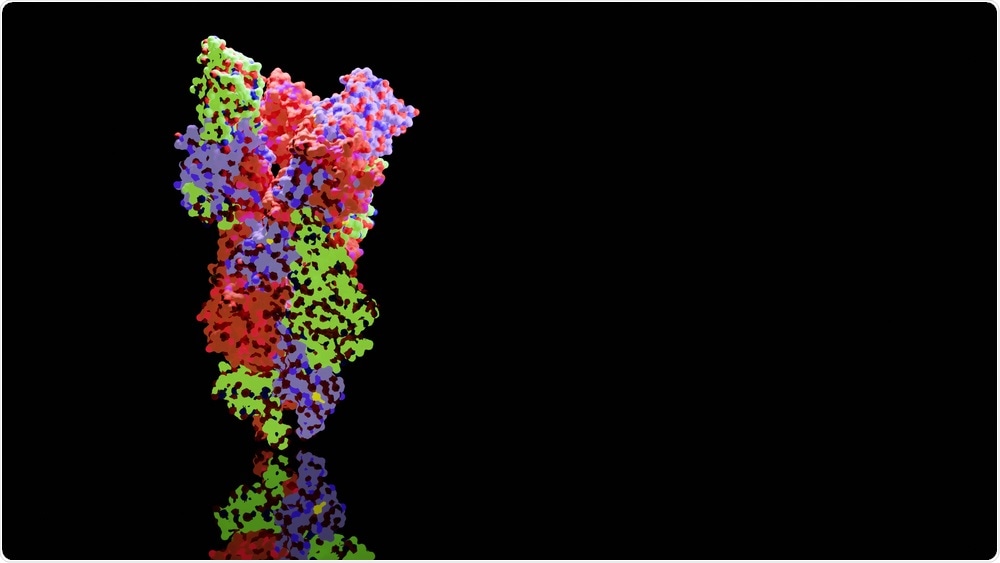The severe acute respiratory syndrome coronavirus-2 (SARS-CoV-2) is a ribonucleic acid (RNA) virus that causes the coronavirus disease 2019 (COVID-19). RNA viruses are prone to high rates of mutation. In fact, it has been reported that in SARS-CoV-2, 10−3 substitutions occur on each site of the virus every year.
 Study: Mutational hotspot in the SARS-CoV-2 Spike protein N-terminal domain conferring immune escape potential. Image Credit: sanjaya viraj bandara / Shutterstock.com
Study: Mutational hotspot in the SARS-CoV-2 Spike protein N-terminal domain conferring immune escape potential. Image Credit: sanjaya viraj bandara / Shutterstock.com
Background
During the COVID-19 pandemic, an increase in mutations in the viral genome was observed. In order to survive, SARS-CoV-2 adapts to the host and evades the host immune system, thereby leading to the development of mutations in its genome.
These mutations are especially prevalent in the S gene, which encodes for the spike protein. Previous studies have mostly focused on the mutations on the spike protein's receptor-binding domain (RBD).
In a recent study published on the preprint server bioRxiv*, the researchers discuss mutations in the N-terminal domain (NTD) of the spike protein, which contains an antigenic "supersite" and is the target for neutralizing antibodies (nAbs). The study explores the potential impact of NTD mutations on infectivity and immune evasion and highlights the importance of investigating mutations occurring in regions other than the RBD of the spike protein.
Tryptophan at position 152 (W152) is a mutational hotspot in the Spike gene
The SARS-CoV-2 genome in the SOPHiA DDM database was screened for mutations on the S gene. Distinct mutations were identified in the NTD of the spike protein at the W152 position.
At this position, tryptophan was identified to be substituted by Leucine (W152L) or arginine (w152R), and less frequently by Cysteine (W152C) or glycine (W152G). Clades are a group of organisms that include a single ancestor and all of their descendants.
In the CAL.20C clade (B.1.429 lineage), which caused the COVID-19 outbreak in Southern California, a W152C substitution was reported. Thus, frequent and diverse mutations at a single position have been known to play an adaptive role in SARS-CoV-2.
Worldwide prevalence of W152 mutations
The current study explored the pattern of W152 mutation recruitments in global datasets in the GISAID database. Between December 2020 and April 2021, which corresponds to the second pandemic wave, W152C, W152L, and W152R mutations were frequent. Furthermore, these mutations were found to be associated with 171 independent recruitments traced since the early stages of the pandemic.
The largest cluster with 13,000 occurrences in 30 countries was reported for the W152C substitution, including the "Californian variant" (CAL.20C lineage). The second-largest cluster was reported in 20 countries with 1,500 sequences having the W152L substitutions. Most of the clusters were small in size and occurred in only one country, thus suggesting that these mutations were independent recruitments and not due to cross-border transmissions of viruses bearing W152 mutations.
The W152 mutations in the spike protein were most prevalent during the week 65-75 of the pandemic. These findings identified W152 as one of the most dynamic spike positions for mutation recruitments. W152 and the NTD residue D80 are the only two spike residues having three independent substitutions reported to occur at least 500 times in GSAID.
The current study explored spike mutations that frequently co-occur with W152 substitutions in order to determine if W152 mutations may provide an evolutionary advantage to SARS-CoV-2. The D614G mutation was identified as the only mutation that co-occurred with all three W152 substitutions. Each W152 mutation had a different spike mutation that co-occurred at high frequency.
The authors of this study also wanted to estimate the frequency of co-occurring mutations. To this end, they found that in 67.8% of cases, the W152 substitution did not co-occur with any well-known RBD mutations known to confer an advantage for SARS-CoV-2 survival.
W152 mutations promote immune evasion
The evolutionary constraints that drive mutations on the spike protein are specific for each distinct region. Increased angiotensin-converting enzyme 2 (ACE2) receptor binding and evasion of neutralizing antibodies (nAbs) drive the mutations in the RBD domain, while nAb evasion predominantly drives the NTD mutations.
Next, the scientists explored how W152 mutations will influence nAbs recognition of the NTD domain. A total of five spike NTD structures were generated with mutations W152L, W152R, and W152C, with each of the NTDs bound to a nAb.
Sidechain optimization and binding free energy (ddG) analyses were performed. It was found that the mutations decreased the affinity of the nAb to the NTD. The degree of affinity reduction was determined by the extent to which W152 participation was required at the interacting surface.
NTD is present at the exposed part of the spike protein, thereby making it an important target for antibodies. Both mutations in the RBD and NTD may facilitate immune evasion by the virus.
As mutations in the RBD may disrupt interactions with the ACE2 receptor, they are evolutionarily constrained; however, this is not the case with NTD mutations. Therefore, mutations in the NTD may be an evolutionary disguise that the virus adopts for immune evasion. Numerous nAbs against the NTD target ACE2-independent cell entry and increased incidences of NTD mutations may confer an advantage to SARS-CoV-2 for efficient entry into the host.
Interestingly, during the first wave of the pandemic, all the spike domains exhibited an even distribution of mutation recruitments. Comparatively, during the second wave, the NTD exhibited an elevated number of mutations when compared to the other regions.
A statistically significant increase in mutations was observed in the NTD of the spike protein during the second wave. This may be a response to an increase in global immunity in order to confer a survival advantage to SARS-CoV-2.
Mutation recruitments in the NTD were found to be greater in the RBD or other regions of the spike protein in related viruses as well. These findings suggest that mutations in the NTD region have a higher possibility of conferring advantages to SARS-CoV-2 as compared to other regions on the spike protein.
Implications
The present study demonstrates that the NTD domain is prone to rapid evolutionary changes when compared to other parts of the spike protein. This was prevalently observed during the second wave.
W152 has been identified as a mutational hot spot in the NTD domain across many phylogenetic and geographical contexts. Since the end of 2020, an increased incidence of mutation recruitment events has been observed in this region.
Mutations in the W152 position, along with other co-occurring mutations, may increase the infectivity of SARS-CoV-2, as observed with the B.1.429 variant. Mutations in the W152 position may also promote immune evasion, which is evident in the case of R.1 lineage having the W152L mutation that caused a local outbreak in a population of subjects who had been vaccinated.
Based on the findings from this study, efforts should focus on monitoring the mutations in the NTD region. Apart from tracing the emergence of variants of concern, efforts should also be made to identify the emergence of individual or combination mutations that may influence SARS-CoV-2 infectivity. In addition, identifying nAbs that are effective against variants harboring mutations on the spike protein may also be an effective strategy to combat COVID-19.
*Important notice
bioRxiv publishes preliminary scientific reports that are not peer-reviewed and, therefore, should not be regarded as conclusive, guide clinical practice/health-related behavior, or treated as established information.
- Kubik, S., Arrigo, N., Bonet, J. & Xu, Z. (2021). Mutational hotspot in the SARS-CoV-2 Spike protein N-terminal domain conferring immune escape potential. bioRxiv. doi:10.1101/2021.05.28.446137. https://www.biorxiv.org/content/10.1101/2021.05.28.446137v1
Posted in: Medical Science News | Medical Research News | Disease/Infection News
Tags: ACE2, Angiotensin, Angiotensin-Converting Enzyme 2, Antibodies, Arginine, Cell, Coronavirus, Coronavirus Disease COVID-19, Cysteine, Enzyme, Frequency, Gene, Genome, Glycine, Immune System, immunity, Leucine, Mutation, Pandemic, Protein, Receptor, Respiratory, Ribonucleic Acid, RNA, SARS, SARS-CoV-2, Severe Acute Respiratory, Severe Acute Respiratory Syndrome, Spike Protein, Syndrome, Tryptophan, Virus

Written by
Dr. Maheswari Rajasekaran
Maheswari started her science career with an undergraduate degree in Pharmacy and later went on to complete a master’s degree in Biotechnology in India. She then pursued a Ph.D. at the University of Arkansas for Medical Sciences in the USA.
Source: Read Full Article
